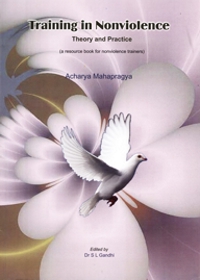As a person begins to realize the equality of the souls, his respect for life will also increase. I feel that there isn’t much respect for life today. If it were so there wouldn’t be unnecessary violence. It is true that violence existed even in the ancient times but the people of those times refrained from unnecessary violence. In India there was a time when there were some ethical norms even for a war. There was a code of conduct for warriors. Everyone who took part in the war followed the code of conduct - “No one will attack an unarmed man.” We come across several examples in the story of the Mahabharata when unarmed persons were spared. It shows that they had great respect for life. It was because of his commitment to respect for life that the emperor Chetak who was a disciple of Lord Mahavira had taken a vow that he would not strike first. He would hit back only when someone tried to hit him. He fought a battle with another king Kaunik. The emperor Chetak came to the battlefield but didn’t initiate the first strike with his weapon. Everyone knows that the Kauravas and the Pandavas fought with their weapons in the day but as soon as the sun set the battle stopped. During the night they sat together, talked and ate together. In the morning they again got ready to fight. It was the ethical code of conduct, which was adhered to even in a battlefield. This ethical code of conduct, which was practised, by the ancient heroes and warriors has disappeared today. In the modern age it is during the night that the heavy bombing is resorted to. In the modern warfare nothing is taken into consideration. Fighting can break out during the night or during the day. There is no time for meals, or for sleeping. Nor is there any ethical binding which prohibits the first strike. It all means that today life is not as respected as it should be. One will have no respect for life unless one learns the real value of life. There will be no respect for life so long as the consciousness for the nonviolence is not awakened.
Today violence is limitless whereas in the ancient times there was a limit to it. The people thought of limiting not only the items of eating but also their violent activities. While digging the earth they were careful and didn’t cross the limit of digging they had voluntarily decided. One of the main problems today is that of environment. Excessive exploitation of the land and natural resources, wastage of water and felling of trees has created the problem of environment. It will not be wrong if I say that environment itself is instrumental in the increase of violence today. If the human mind is not healthy, violence cannot be stopped and one cannot even think of peace. He who doesn’t see trees and plants cannot have a healthy mind. Both man and vegetation are so intimately connected that the nearer to nature man is, the healthier is his mind. It appears that all the cultures of the world today have decided to keep the human mind unbalanced. How can a person who remains shut in a room for twenty four hours have a healthy mind? Urbanization and creation of big cities have obviously created some problems and indirect violence has been encouraged. In a village since every man lives in an open house and goes out for a walk, his mind is healthy. It is an example of natural living. It is very helpful to the growth of the idea of nonviolence and peace. As the artificial life increases, reverence for life decreases. This mindset nourishes the cells in the brain, which cause violence. We may try as much as we can, discussion on nonviolence cannot go ahead till our lifestyle, which triggers violence is transformed. In order to achieve the objective of creating a lifestyle essential to promote nonviolence and in order to have the right type of thinking and awakening the development of the cells responsible for this favourable situation is necessary. We will not succeed in any of our endeavour till it happens.
 Acharya Mahaprajna
Acharya Mahaprajna

